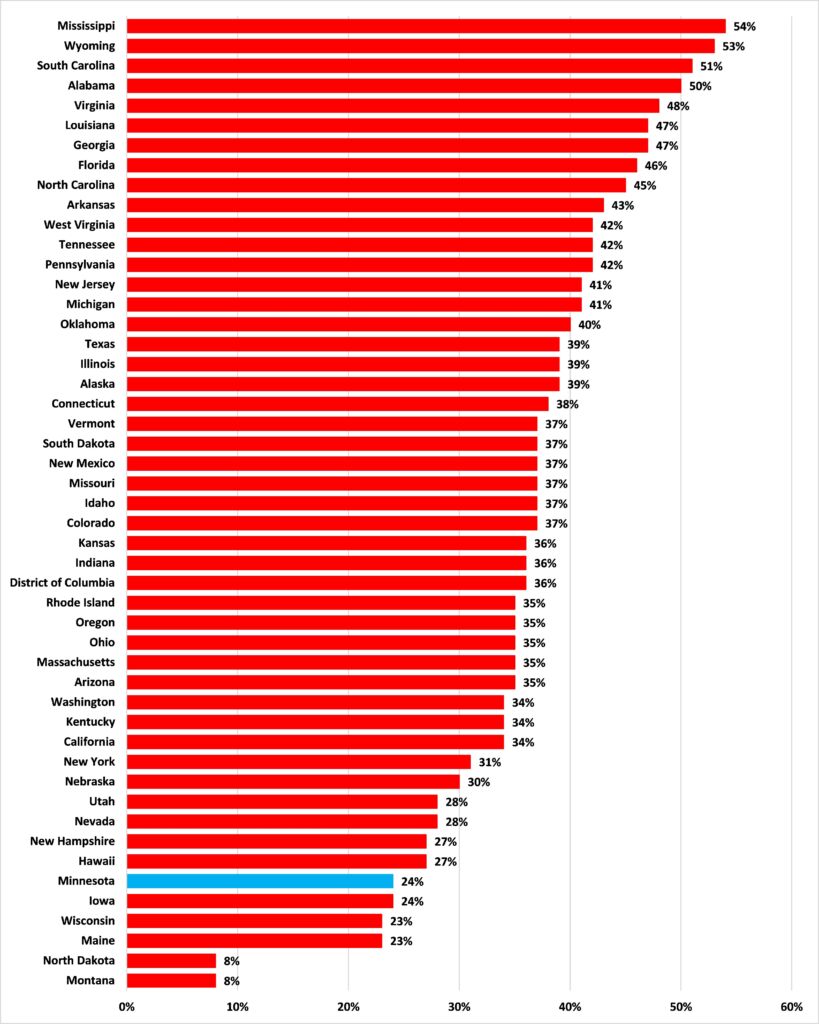Digging deeper into Minnesota’s racial disparities
In my Star Tribune op-ed ‘Minnesota, we have a problem‘ last month, I mentioned our state’s racial disparities. Among others, I mentioned the disparity in homeownership rates specifically.
In June, the Star Tribune reported that the racial homeownership gap in the Twin Cities is the highest in the United States:
A little more than a fifth of Black households own their homes, compared with nearly three-quarters of all white households.
As I noted in my op-ed:
Even worse, for Black Minnesotans some of these outcomes, like homeownership rates, are not just low relative to those for white Minnesotans but relative to those for Black residents of other states.
Indeed, out of 48 states and the District of Columbia, Minnesota ranks joint fourth from the bottom for the Homeownership rate among African Americans, as Figure 1 shows.
Figure 1: Homeownership rate among African Americans

Source: Statista (No figures are given for Delaware and Maryland)
The question of what is behind this and other such outcomes is one of the most pressing in Minnesota’s public policy debate. Some fascinating light was shed on this recently by Nathan Arnosti of the Center for Economic Inclusion.
Writing on Twitter, Arnosti noted that Minnesota’s ‘black’ population differs from the ‘black’ population in other states in important respects. At eight percent, our state’s black population is the joint 23rd smallest in the United States, below the average of 12 percent. But within that, as Arnosti notes, “around 40% of Black Minnesotans are recent immigrants…By comparison, just 9% of Black residents across the US are recent immigrants.” Furthermore:
Nationally, half of Black immigrants come from the Caribbean: Jamaica and Haiti in particular, or from West African countries like Nigeria.
…
In Minnesota, by contrast, 70% of Black immigrants come from two countries in East Africa: Somalia and Ethiopia
These two groups are very different, as Agnosti explains:
Many Caribbean & West African immigrants arrived via family reunification or lottery. They have more education, more wealth, & higher rates of homeownership than US-born Black residents.
…
As many Minnesotans know but non-Minnesotans might not, many East African immigrants are refugees. They’ve fled extremely unstable conditions in their home countries.
As this might lead us to expect:
West African communities in Minnesota – Liberian, Kenyan, Nigerian – do have somewhat higher incomes and homeownership rates, similar to national trends. But East African communities – Somalis in particular – do not.
To some extent, then, the disparities in homeownership rates we see between Minnesota’s black and white residents and the relatively poor record of black homeownership here compared to other states is a function of our state’s black population being different to that in other states. This obviously ought to inform any policy response to the problem of disparate homeownership rates.
Agnosti concludes by pointing out that:
More broadly, this a reminder that Black communities across the US are not monolithic. They face distinct barriers & have different needs, values, norms. It’s simply not accurate to talk, as many white people do, about “the Black community” as a singular thing.
He is exactly right. Dumping people into these broad, macro categories often obscures as much as it reveals.